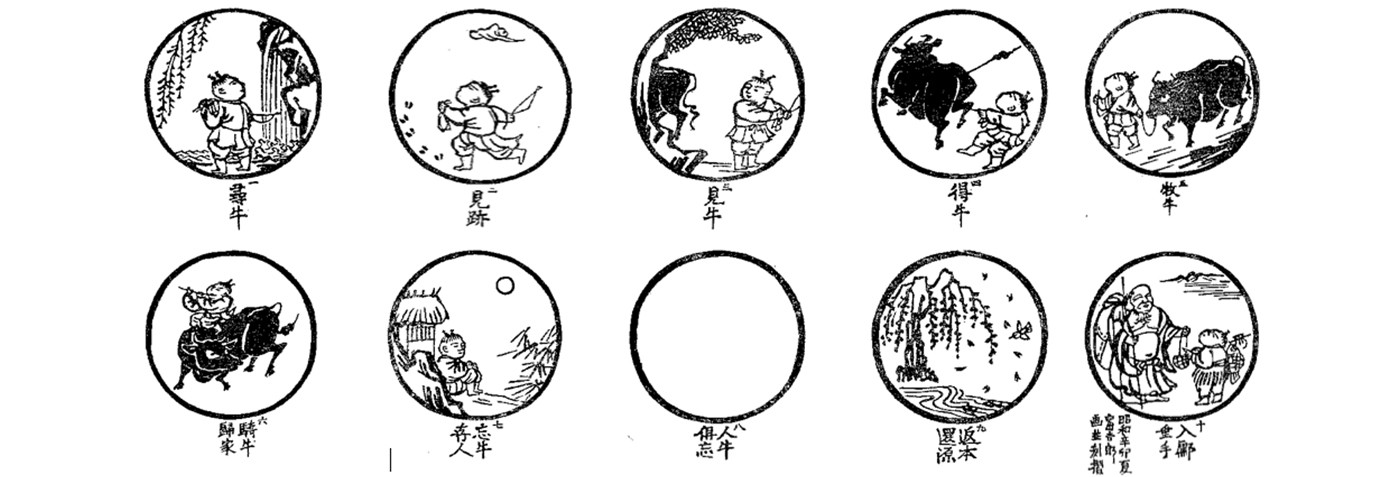The 10 Oxherding Pictures: A Manual of Zen Training
The oxherding imagery dates as far back as the 4th century, and perhaps earlier. This version, with 10 pictures, poems and introductory words attached to each, was composed in the 12th century as a training guide for Chinese Buddhist monks. It continues to be used today as a teaching tool in Zen monasteries in Japan, providing students with useful imagery of an illusion to be negated before a seeker of truth can experience enlightenment. In my studies I worked with the version of the oxherding pictures presented below, which was drawn by the 12th century Chinese Rinzai Zen (Chán) master Kuòān Shīyuǎn.
10 stages of a practitioner’s progression towards the purification of the mind and enlightenment.
Its purpose is to help the student to experience and relate to the unifying element within, by meditating on each picture. This process is intended to help you find who you are, and exactly where you are in your inner development. If you look at the pictures with an open heart, you might reach the stage of development in your life where detachment and compassion — like eternity and time — become a living reality. It’s a quest to find the inner treasure and share it with others.
People look for the Way in many directions: traveling around the world; changing careers, partners and spouses; through promotions, money, titles, and myriad other things. But the Way that is described here, “the Bull,” is not outside and not in another place. It is as near as oneself — very close, like a breath.
You cannot know what you are looking for until you find it!
1. The Search for the Bull:
In this world, I struggle and push against the many forces acting on me as I search for the Bull. I exhaust my energies in some unprofitable pursuits, without any clear aim. I may find some things to distract me. I may even settle — on a golf course in Florida — and die. Some have hope and the possibility of developing a permanent soul. This journey is definitely not for everyone.
Comments: Why search if the Bull is never lost in the first place? Since I am separated from my true nature, I create this struggle. Because of my fears, greed, judgment, and a myriad other reasons, I look for it far away. What a pity.
2. Discovering the Footprints:
I see traces of the Bull’s footprints. They aren’t totally wiped out, but I have to really look for them under all the distractions of life — school, job, car, sex, mortgage, children, dramas. When I look very carefully, I can see his traces as clearly as one can see his nose looking up to heaven.
Comments: I begin to walk on the path, like mounting a horse for the first time after a long period of neglect. I realize that what I call the “i” is no more than a multitude of desires and thoughts pulling me this way and that way. I have to develop a discriminating part — “an observer” — that can discern the true from the not-so-true. But these are all from the same fabric of the self — the permanent “I” — which I don’t possess. There are so many different selves, these little “i’s.” Which one of them do I listen to? The mind is a jungle, with so many thoughts pulling me this way and that. I haven’t yet reached the gate, but I see the path. There is a tendency to take a detour or fall off the horse.
3. Perceiving the Bull:
The path is so beautiful, full of flowers and the warmth of the sun shining on my back. I see a part of the Bull clearly, with his horns and big head.
Comments: I have a little taste of this oneness. Like salt and water, all my senses are unified. I can see the interconnectedness of all things in nature.
4. Catching the Bull:
The Bull is so powerful that it takes all of my force to grab him. But I cannot, as he takes off in the tall grass looking for something else. My bubble of infatuation with catching him today quickly bursts. The Bull has been on his own for so long that he wants to continue on his own, searching for sweeter grass.
Comments: I wish to stay on the path and on the horse, but I need discipline to maintain the path. Recognizing my aim, I have to use skillful means to stay the course. I can employ reward and punishment to stay true to my aim. I see how quickly my mind is distracted and I am pulled every which way.
5. Taming the Bull:
Like using the “whip and rope” on a horse, I need a strong sense of willpower and discipline to keep the Bull on the path. Otherwise he could lose himself down an alley. It is a daily practice — one minute at a time — to observe, to make room for the big “I” to be a unifying force so that I am not distracted or pulled away by the different and contradictory “i’s.”
Comments: Each thought has to be guarded against. Thoughts are like monkeys swinging from branch to branch. The task is to stay centered, observing these thoughts and not allowing any one of them to distract me.
6. Riding the Bull Home:
The struggle is over as I find a center: a permanent “I” that unifies the whole. I continue to move forward, undistracted by the forces that want to pull me back.
Comments: Slowly I return home, sitting on the Bull. The notes from my flute fill the night. The harmony has an endless rhythm and whoever hears it is affected by it. The ripple effect of my thoughts and actions is very vivid.
7. The Bull Transcended:
I ride the Bull home. I am contemplative and restful as the Bull rests too. I see the dawn of a new day and I do not need the rope and the whip to control the Bull. I live with joy in my simple life.
Comments: I experience oneness as dualistic thoughts are transcended. The Bull is a temporary subject of mind and the path is now clear ahead. I am actively engaged in the search for consciousness and in developing an attention that can know its Source.
8. Both Bull and Self Transcended:
Everything is transcended into oneness, No-Thing: no Bull, no rope, no whip, no person. Here we can see the footprints of the ancestors that have walked this path before us.
Comments: The mind is clear of limitations, as there is nothing to seek. I seek no enlightenment, and neither do I remain where no enlightenment exists.
9. Reaching the Source:
After this long journey I return to the Source, where everything is in full bloom.
Comments: When not attached to form there is nothing to reform. Truth is clear as myriad forms rise and fall.
10. In the World:
I am back in the marketplace, where I mingle with the people in the world. Life is magical and blissful. I live my life fully and everything becomes alive.
Comments: In the marketplace, everyone I come into contact with becomes enlightened.
The ox symbolizes the mind and the herder symbolizes the seeker.
十牛 Zen stages of a practitioner’s progression towards the purification of the mind and enlightenment, as well as his or her subsequent return into the world, while acting out of wisdom, compassion and service.
The Take Away
Developing your consciousness through a regular meditation practice is key for your success and survival in a very complex world. Many people take up meditation like a new hobby and neglect the necessary self-reflection and inner work that it takes to create real change and develop consciousness. You may feel good while you meditate, floating on some kind of cloud nine, and then return to your regular life and find that all the same conditions come flooding back – negativity, fears, difficulties, monkey chatter in the brain, the usual self-doubt and questioning. You will only discover the true value in these ancient practices if you choose to take them up as a life “koan”. I suggest that you commit to the practice of inner work, wholeheartedly, for life! Imagine committing to something so important as developing your emotional intelligence, your consciousness, exercising your mind…for a whole lifetime. Surely, that’s a worthwhile pursuit?
# LifeLesson #Meditation #Zen #Mindfulness #Consciousness #Self Awareness



